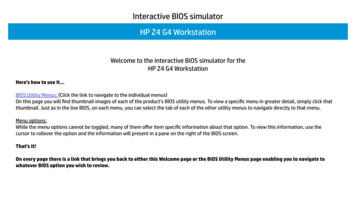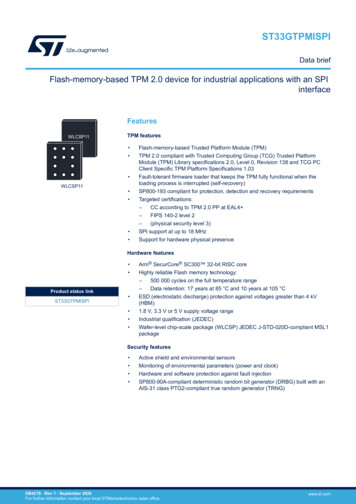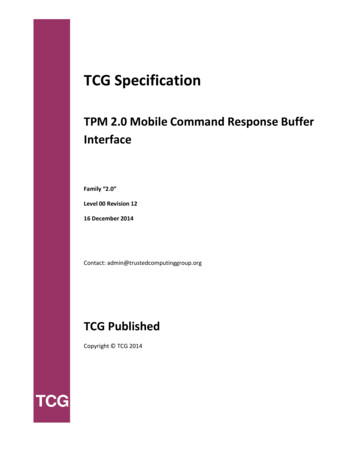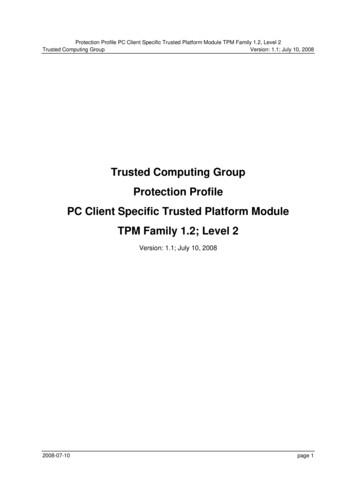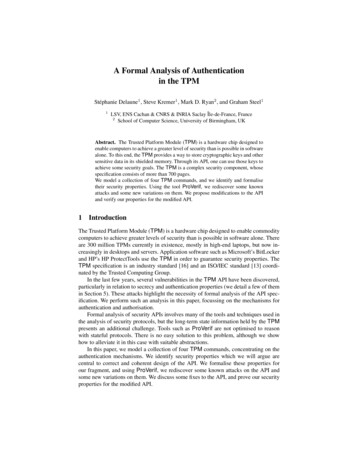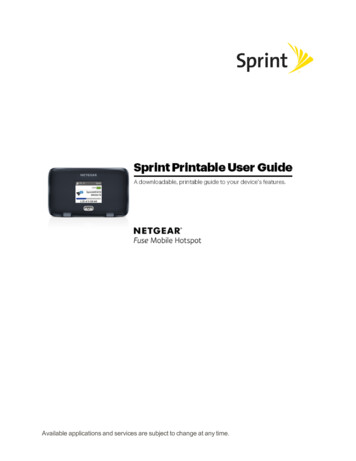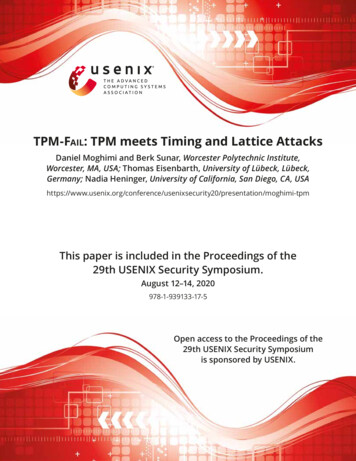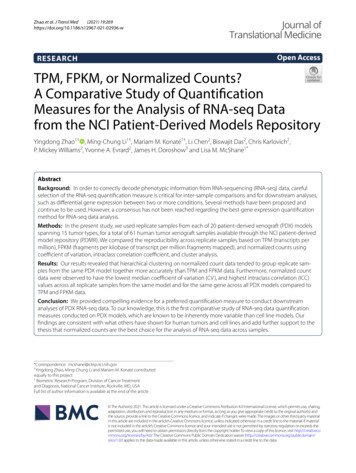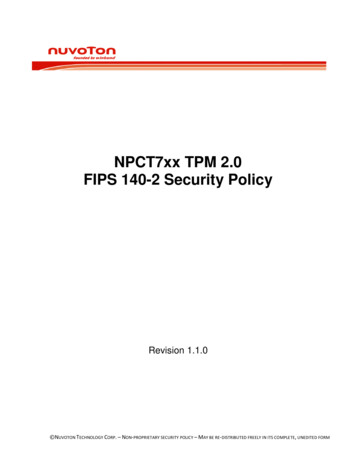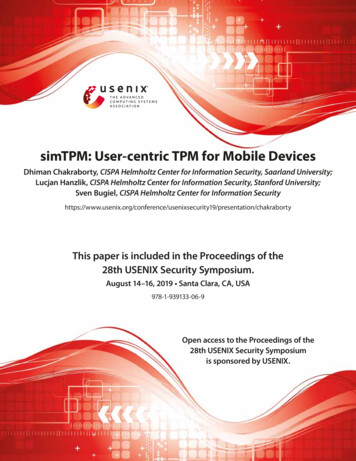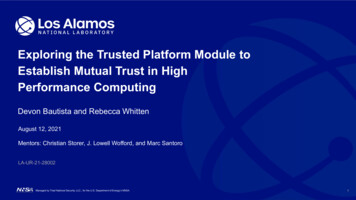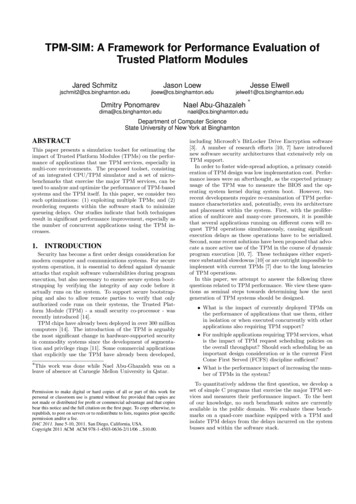
Transcription
TPM-SIM: A Framework for Performance Evaluation ofTrusted Platform ModulesJared SchmitzJason LoewJesse n.edujelwell1@cs.binghamton.edu Dmitry Ponomarevdima@cs.binghamton.eduNael Abu-Ghazalehnael@cs.binghamton.eduDepartment of Computer ScienceState University of New York at BinghamtonABSTRACTThis paper presents a simulation toolset for estimating theimpact of Trusted Platform Modules (TPMs) on the performance of applications that use TPM services, especially inmulti-core environments. The proposed toolset, consistingof an integrated CPU/TPM simulator and a set of microbenchmarks that exercise the major TPM services, can beused to analyze and optimize the performance of TPM-basedsystems and the TPM itself. In this paper, we consider twosuch optimizations: (1) exploiting multiple TPMs; and (2)reordering requests within the software stack to minimizequeueing delays. Our studies indicate that both techniquesresult in significant performance improvement, especially asthe number of concurrent applications using the TPM increases.1.INTRODUCTIONSecurity has become a first order design consideration formodern computer and communications systems. For securesystem operation, it is essential to defend against dynamicattacks that exploit software vulnerabilities during programexecution, but also necessary to ensure secure system bootstrapping by verifying the integrity of any code before itactually runs on the system. To support secure bootstrapping and also to allow remote parties to verify that onlyauthorized code runs on their systems, the Trusted Platform Module (TPM) - a small security co-processor - wasrecently introduced [14].TPM chips have already been deployed in over 300 millioncomputers [14]. The introduction of the TPM is arguablythe most significant change in hardware-supported securityin commodity systems since the development of segmentation and privilege rings [11]. Some commercial applicationsthat explicitly use the TPM have already been developed, This work was done while Nael Abu-Ghazaleh was on aleave of absence at Carnegie Mellon University in Qatar.Permission to make digital or hard copies of all or part of this work forpersonal or classroom use is granted without fee provided that copies arenot made or distributed for profit or commercial advantage and that copiesbear this notice and the full citation on the first page. To copy otherwise, torepublish, to post on servers or to redistribute to lists, requires prior specificpermission and/or a fee.DAC 2011. June 5-10, 2011. San Diego, California, USA.Copyright 2011 ACM ACM 978-1-4503-0636-2/11/06 . 10.00.including Microsoft’s BitLocker Drive Encryption software[3]. A number of research efforts [10, 7] have introducednew software security architectures that extensively rely onTPM support.In order to foster wide-spread adoption, a primary consideration of TPM design was low implementation cost. Performance issues were an afterthought, as the expected primaryusage of the TPM was to measure the BIOS and the operating system kernel during system boot. However, tworecent developments require re-examination of TPM performance characteristics and, potentially, even its architectureand placement within the system. First, with the proliferation of multicore and many-core processors, it is possiblethat several applications running on different cores will request TPM operations simultaneously, causing significantexecution delays as these operations have to be serialized.Second, some recent solutions have been proposed that advocate a more active use of the TPM in the course of dynamicprogram execution [10, 7]. These techniques either experience substantial slowdowns [10] or are outright impossible toimplement with current TPMs [7] due to the long latenciesof TPM operations.In this paper, we attempt to answer the following threequestions related to TPM performance. We view these questions as seminal steps towards determining how the nextgeneration of TPM systems should be designed. What is the impact of currently deployed TPMs onthe performance of applications that use them, eitherin isolation or when executed concurrently with otherapplications also requiring TPM support? For multiple applications requiring TPM services, whatis the impact of TPM request scheduling policies onthe overall throughput? Should such scheduling be animportant design consideration or is the current FirstCome First Served (FCFS) discipline sufficient? What is the performance impact of increasing the number of TPMs in the system?To quantitatively address the first question, we develop aset of simple C programs that exercise the major TPM services and measures their performance impact. To the bestof our knowledge, no such benchmark suites are currentlyavailable in the public domain. We evaluate these benchmarks on a quad-core machine equipped with a TPM andisolate TPM delays from the delays incurred on the systembusses and within the software stack.
To address the second and third questions, we integrate aTPM software emulator [2] with a cycle-accurate simulatorof a modern microprocessor [5]. We use empirically obtainedTPM delays to model TPM latency in the simulator. Thetool (called TPM-SIM) allows us to accurately explore design alternatives in a realistic environment. We use it tostudy the impact of using multiple TPMs and to evaluatethe impact of request scheduling policies on performance. Ingeneral, the combination of the new benchmark set and anintegrated CPU-TPM simulator provides a valuable TPMperformance analysis tool that can be used both to assessthe performance of applications using the TPM as well asto guide the design of future TPMs. Our studies indicatethat for four programs simultaneously using TPM services,simple request reordering to minimize queueing delays results in a 35% performance improvement on average, whileadding two more TPMs (for a total of three TPMs in thesystem) improves the performance by a factor of 2.8X.2.BACKGROUNDThis section provides a short summary of TPM, sufficientto understand the operation of the benchmarks that we developed in this study. For more detailed description, we referthe readers to [4, 6].2.1TPM and the Root of TrustThe TPM (Trusted Platform Module) was designed toprovide a local root of trust for each computing platform,providing both static and dynamic root of trust. Static Rootof Trust for Measurement (SRTM) measures code modulesat system’s boot time before the code is allowed to execute.If a measured code fails (its hash does not match the expected value), the boot process can be blocked by a trustaware bootloader such as TrustedGRUB[16].Dynamic Root of Trust for Measurement (DRTM) is amechanism available in implementations such as IBM’s Integrity Measurement Architecture in the Linux kernel. Itallows measuring the integrity of a code module at any timeduring system operation. In either case, the code integritymeasurements amount to computing a cryptographic hashover the code before it is executed. For SRTM, the measurement is performed on the TPM chip itself, while forDTPM the cryptographic hashes are computed in softwareand are then extended into a Platform Configuration Register (PCR) in the TPM chip. This mechanism makes it possible to perform TPM-based remote attestation to a thirdparty interested in the platform state.In PC-based systems, the TPM is located on the Low PinCount (LPC) bus. Because the TPM has a relatively simplebyte-stream interface to the LPC bus, a software stack isspecified by the TCG to expose a more flexible set of operations to user-space code. The Trusted Software Stack (TSS),informally known as TrouSerS, provides richer functionality for application developers and abstracts away vendorspecific interfaces. Its most important abstraction is theserialization of requests to the TPM. The TPM can onlyprocess one command at a time and will return a busy signal when prompted to perform another. The Trusted CoreServices daemon (TCSD) is responsible for this serialization.2.2TPM Performance LimitationsIn general, existing TPM implementations favor cost overperformance. Because of its location on the LPC bus on x86-based architectures, the TPM has a low bandwidth (2.56MB/s average throughput) [8]. Although the LPC is capable of direct memory access, the TCG specification forbidsthe TPM from using it at all. There are two main sourcesof delay within the TPM logic: RSA key generation and encryption calculation. The RSA algorithm [12] requires primenumbers, which are fed into the RSA engine from the TPM’srandom number generator. Since there is no guarantee thatthe numbers generated will be prime, a statistical test mustbe done to check for primality. This is an expensive processand is also non-deterministic if the numbers are truly random. In addition, when the sealing operation (encrypting toTPM state) is performed on data, the RSA encryption mustbe done internally within the TPM [10], as the current stateof the PCRs are recorded in the resulting ciphertext andmalicious programs cannot be allowed to spoof PCR values.Another problem impacting performance relates to the implementation of the Trusted Software Stack through whichapplications interact with the TPM. Because the TPM onlyreads and writes byte-streams, all of its operations must beatomic. To enforce atomicity, the TCSD will serialize allrequests to the TPM. In the current implementation, theserequests are handled in a First Come First Served (FCFS)fashion, which can severely delay applications with short requests and substantially degrade system throughput. Consequently, alternative request scheduling schemes can be moreefficient, and we evaluate them in this paper.To address these performance bottlenecks without changing the internal architecture and functionality of TPM chipsthemselves, the following options are possible: Alternative placement of TPMs closer to the mainCPU (such as within the memory controller). The use of multiple TPM chips to allow concurrentprocessing of multiple requests Better TPM request scheduling algorithms for multiprogrammed workloads.In the rest of the paper, we present evaluation of these proposals using the combination of a real TPM-based multicoreplatform and a novel simulation framework (TPM-SIM).3.TPM BENCHMARK SUITEBecause there were no publicly available TPM benchmarks, the first goal of this study is to develop a benchmarksuite that exercises the set of major TPM services. Our goalis not to create large-scale applications; rather, we seek aset of simple mini-benchmarks that intermix the TPM callswith some regular processing. Having a separate benchmarkfor each of the major services allows us to evaluate them inisolation or in combination (on multiple cores).3.1TPM BenchmarksThe benchmarks were written using the Trusted ServiceProvider interface (TSP). There is one instance of the TSPfor each application that wishes to use TPM services, andeach TSP establishes a software context with the TCSD.The TSP interface is a simple C API, giving the developeras much flexibility as possible, without relying on knowledgeabout the internals of the software stack. Every benchmarkis written to exercise only one TPM functional unit such asthe Random Number Generator (RNG). The benchmarksare described in more detail below.
Key Generation Benchmark (KEY): The first benchmark (called KEY) exercises the secret RSA key generationcapability of the TPM. The measured function isTspi Key CreateKey(). KEY times how long it takes theTPM to create a user-defined key wrapped with the storageroot key. Simplified pseudo-code for the KEY benchmark isshown in Figure 1.f o r ( i 0 ; i k e y c o u n t ; i ) {./ / ONLY c a l l d o w n t o TPM i s h e r ec l o c k g e t t i m e (CLOCK REALTIME, &s t a r t ) ;r e s u l t T s p i K e y C r e a t e K e y ( h S i g n i n g K e y , hSRK ,;c l o c k g e t t i m e (CLOCK REALTIME, &end ) ;.}.The TPM is limited in the maximum data size that in canseal in one function call by the modulus of the key used forencryption. It is therefore the application’s responsibility tobreak longer data into blocks, call Tspi Data Seal() repeatedly and then recombine the encrypted data. However, thisbehavior introduces cache misses, along with disk and memory I/O into the timings. Instead, we chose to mandate asmall input size and call Tspi Data Seal() on the same inputbuffer numerous times, reporting the average.The benchmark code is available athttp://www.cs.binghamton.edu/ tpmsim/download.html.0)Figure 1: C code for Key BenchmarkKey Loading Benchmark (LOAD): This benchmark (calledLOAD) loads a single key or a hierarchy of keys into theTPM and then evicts it. The measured function calls areTspi Key LoadKey() and Tspi Key UnloadKey(). It timeshow long it takes to load and unload a daisy chain of keysto and from the TPM. The calls are measured identically tothe method used above.Remote Attestation Benchmark (PCR): The purposeof this benchmark is to exercise the TPM’s remote attestation capability. It measures the time of the function callsTspi TPM PcrExtend() and Tspi TPM Quote2(). Essentially, this benchmark quantifies how long it takes the TPMto extend PCRs and to fulfill a quote request conforming tov1.2 of the TCG specification: these are the basic operationssupporting remote attestation. The benchmark allows theuser to specify the length of the data to be extended intothe PCRs, how many times to extend each PCR, the number of Quote operations to perform, and which PCRs shouldbe involved in these operations. Simplified pseudo-code ispresented in Figure 2.4.EXPERIMENTAL EVALUATIONIn this section, we present results obtained by evaluatingthe set of benchmarks described in the previous section on amodern multicore system. The experiments are performedon a a quad-core Intel Core i7 processor that supports Intel’sTrusted Execution Technology (TXT). Figure 3 shows thehigh-level architecture of the experimental platform. Theparameters of the TPM chip deployed in the machine usedfor our experiments are described in Table 1.Core 0Core 1Core 2Core 3TPM Requestsfrom all coresTrusted SoftwareStack(TSS or Trousers)TPMTPMRequestQueueFigure 3: System OverviewPerformQuerytorequiredfindsetupvariableso u t how many PCRs a r eC r e a t e Random d a t aForo f TPM andtoavailableExtend PCRs w i t he a c h PCR t h a t we w i s h t o e x t e n d :I f u s e r s p e c i f i e s data l e n g t h :Hash i n s o f t w a r e and e x t e n d PCRElse :Extend PCRG e n e r a t e AIK f o r q u o t i n g PCRsFor e a c h PCR t o be q u o t e d :Quote PCRFigure 2: Pseudocode for PCR BenchmarkTiming the Random Number Generator (RNG): Thisbenchmark times the random number generator on the TPM.The measured function calls are Tspi TPM StirRandom()and Tspi TPM GetRandom(). Thus it measures the latencyof adding to the entropy pool of the onboard RNG and togenerate random numbers of variable length.Data Sealing Benchmark (SEAL): The final benchmarkmeasures the perfomance of the RSA encryption engine,which supports data sealing. It measures the following function calls: Tspi Data Seal() and Tspi Data Unseal(). Specifically, this benchmark quantifies the latency of sealing andunsealing a single block of data according to the PCR state.ParameterTCG ComplianceLow Pin Count InterfaceArchitectureValueV1.1B / V1.233Mhz, V1.11088-bit Modular Arithmetic ProcessorHardware-based SHA-1 acceleratorTrue RNGs (FIPS 140-2 / AIS-32compliant)Table 1: ST19NP18-TPM Specifications[13]All benchmarks allow for a user-specified number of iterations and the average and total times for all operations arereported. For our results, we ran 1000 iterations with eachdata set (e.g. different key lengths or data sizes for sealing)for all tests to ensure statistical accuracy. Only those function calls that require TPM processing are timed. We usethe real-time clock to measure TPM response times. TPMsthat were manufactured to conform to specifications olderthan 1.2 [15] are not required to support interrupts, so timing becomes difficult (i.e. threads sleeping versus polling).
Using real time gives the beneficial option of running multiple instances of the benchmark to get the accurate measurements for concurrently running benchmarks.We first present the latencies for the individual TPM callsmade by the benchmarks. In total, 18 different calls wereprofiled as summarized in Table 2; please note that the callids in this figure will be used to refer to these calls in theperformance analysis figures. Figure 4 presents the latencies incurred by each such call. As seen from the results, byfar the longest latency is seen in the key generation benchmark for generating 2048-bit keys. The Load benchmarkalso exposes relatively high latencies. Conversely, requestsfor quoting the PCR registers and requests to the randomnumber generator are very fast.Figure 4: Average Latency of Each Call IDTitleKeyLoadPCRRNGSealCall ID123456789101112131415161718Call ID for TPM BenchmarksDescriptionCreate a 512-bit RSA KeyCreate a 1024-bit RSA KeyCreate a 2048-bit RSA KeyLoads a single 512-bit Key and evicts itLoads a single 1024-bit Key and evicts itLoads a single 2048-bit Key and evicts itLoads a hierarchy of keys and evicts themLoads a hierarchy of keys w/o evictingLoads a single key w/o evictionQuotes a PCRExtends a PCR with the default block sizeExtends a PCR with random data and sizeGenerates a 512-bit random numberGenerates a 1024-bit random numberGenerates a 2048-bit random numberGenerates a 4096-bit random numberSeals a fileUnseals a fileTable 2: TPM Call SummaryTable 3 shows the percentage of time that each call spendsin the software stack; the rest of the time is the sum ofbus traversal and processing delays within the TPM itself.As seen from the table, software delays represent less than1% of the overall TPM call delay for all of the cases. Theexperiments also show that the bus delays (including thedelays incurred in traversing the LPC bus) are negligiblysmall, making the TPM processing delays by far the primaryculprit in the overall cost of the TPM calls. For example, thefastest TPM call that we experimented with has a hardwaredelay of 100 milliseconds (200 bytes of data are sent to theTPM in this call). If we assume that the LPC bus has awidth of 4 bits and is clocked at 33 MHz, then 400 buscycles are required to transmit the data with a cycle timeof about 30 nsec. Even in this case, the overall bus delayis only 12 microseconds, which is four orders of magnitudesmaller than the delays within the TPM itself. For othercalls, the difference is even larger. For this reason, we donot distinguish bus delays into a separate component, butrather consider them as part of the TPM delay.TPM Benchmarks: Software TimeBenchmark Call ID Time Spent in 140.13%RNG150.06%160.04%170.83%Seal180.40%Table 3: Percentage of Time Spent in Software Stack5.ALTERNATIVE TPM DESIGNSThe high delays associated with TPM primitives have significant impact on performance for applications that use theTPM. This is especially true in multi-core environments,where many such applications may execute concurrently.To study this impact on system performance, and to enable the exploration of system optimizations, we designeda new cycle-accurate simulation tool (TPM-SIM) that integrates TPM models into existing traditional CPU and memory system simulators. In this section, we give an overviewof TPM-SIM design, then use it to study two optimizationsto TPM performance.5.1TPM-SIM ArchitectureTPM-SIM integrates a cycle-accurate simulator of a modern microprocessor with a software emulator of the TPM.Our processor simulator is M-Sim [9], which was built ontop of Simplescalar simulator [5]. M-Sim provides cycleaccurate models of out-of-order processors, including support for modeling multithreaded and multicore designs. TPMmodeling is provided through a publicly-available softwareTPM emulator [1] that can be compiled to either simulatea TPM or route calls to a hardware TPM.The two simulators are interfaced as follows. When MSim encounters a TPM call, it pauses the executing threadand invokes the TPM simulator with the corresponding call.The TPM simulator returns the number of cycles requiredto service this call and the return values (if necessary) that
Table of Benchmark MixesNumber of Threads Mix Number Benchmarks Mixed1Key - Load2Key - PCR2 Threads3Key - RNG4Key - Seal5Load - PCR6Load - RNG7Load - Seal8Key - Load - PCR9Key - Load - RNG10Key - Load - Seal11Key - PCR - RNG3 Threads12Key - PCR - Seal13Load - PCR - RNG14Load - RNG - Seal15PCR - RNG - Seal16Key - Load - PCR - RNG17Key - Load - PCR - Seal4 Threads18Key - Load - RNG - Seal19Key - PCR - RNG - Seal20Load - PCR - RNG - Sealare provided by the TPM. The delays for each call are determined by our experiments on the hardware TPM, as presented in Table 2. When a TPM call is encountered, theapplication that performed this call is stalled for the numberof cycles corresponding to the delay. All other applicationscontinue to execute. Figure 5 graphically demonstrates theinteractions and interfaces between the TPM-SIM components.Table 4: Concurrent Mixes of ApplicationsFigure 5: Architecture of the TPM-SIM Simulator5.2TPM System OptimizationsWe use TPM-SIM to study two performance optimizations that do not require redesigning of the TPM chip itself. The first study explores re-ordering of pending TPMrequests to avoid having short requests block behind expensive ones. Specifically, we compare Shortest Job First (SJF)scheduling to the default First Come First Served (FCFS)implementation in the TSS scheduler. Note that a largenumber of scheduling schemes (taken from standard operating system scheduling) can be applied here; our goal is tosimply illustrate that the choice of scheduling discipline isan important issue for TPM in multi-threaded setting. Thebest scheduling policy will obviously depend on the workloads being executed by the system in question. Figure 6shows the performance of workloads composed of multipleapplications developed in this study.Table 4 shows the benchmark combinations used. SinceTPM operations are atomic, and the next request cannot begenerated until the previous request from the same application is serviced, there is no difference between the variousscheduling policies when only two applications are running(because at most one request is in the queue at any time).Therefore, we omit 2-threaded experiments from this study.For the rest of the simulated workloads, SJF provides significant improvement in performance (35% on average across allsimulated mixes with a maximum improvement of 81% forone of the 4-threaded mixes). We note that the performancegains increase with the number of concurrent applicationssharing the TPM. In this graph, performance is calculatedas the total number of cycles spent executing these benchmarks (including both calls to the TPM and the rest of thecode) on all cores.As a final note, we mention that this study only considered non-preemptive service within the TPM. However,there does exist a function in the software stack to issue acancellation call to the TPM and it is possible to use Tddli Cancel() (from the lowest layer of the software stack) asa very primitive ”preemption” if it is augmented in such away that it returns the canceled request back into the request queue. In the current TPM implementation, jobs arenot restartable, so exploration of this modification is left forfuture studies.Figure 6: SJF vs. FCFS Scheduling by Mix NumberThe next optimization we evaluated is the use of multipleTPMs located on the same LPC bus. This way, the servicing of multiple requests can proceed concurrently. Figure 7shows the relative performance of the system with multipleTPMs (we considered 2, 3, and 4 TPMs) with respect tothe performance of a single-TPM machine. Naturally, eachapplication can only use one TPM in these experiments (tomaintain consistency), but requests from multiple applications can be executed on different TPMs concurrently.On average across all 4-threaded mixes1 , the system with 2TPMs results in a 1.9X speedup. If 3 TPMs are used, a 2.7Xspeedup is observed, while using 4 TPMs results in a 3.3Xperformance improvement. In practice the magnitude of the1For readability and due to space constraints, we only showthe graphical results for the scenarios with four concurrentlyrunning applications.
performance gains will be determined by the frequency ofTPM calls and the proportion of time that applications waitfor the TPM services. In our experiments, the executiontime was dominated by the TPM calls.For two concurrent benchmarks, the speedup when usingtwo TPMs is 81% on average. For three-threaded workloads, adding a second TPM improves performance by 72%and adding the third TPM achieves a 1.5X performance improvement on average.We note that placing the TPM closerto the processor (i.e. within the memory controller) does notresult in performance improvements unless the TPM chiparchitecture changes, because the bus latency is negligiblecompared to the delay within the TPM itself.Figure 7: Performance of Multiple TPMsOther studies that explore alternative TPM designs andorganizations are enabled with TPM-SIM. The tool (boththe developed benchmarks and the integrated simulation environment) is publicly available athttp://www.cs.binghamton.edu/ tpmsim.6.CONCLUDING REMARKSThe contribution of this paper is to develop a toolset and acollection of benchmarks to evaluate TPM performance under a range of realistic use cases and design options. Anothercontribution is the initial investigation of two performanceoptimizations: reordering of TPM requests within the software stack and the use of multiple TPMs. We demonstratethat both techniques can lead to significant performanceimprovements, especially as the number of concurrent applications using the TPM increases. Our studies indicatethat for four programs simultaneously using TPM services,simple request reordering to minimize queueing delays results in an average of 35% performance improvement, whileadding two more TPMs improves the performance by a factor of 2.7X. The developed toolset will provide designers theenvironment for evaluating future generations of TPM designs. The tool will be made publicly available, encouragingwidespread reevaluation of TPM performance.7.ACKNOWLEDGEMENTSThis material is based on research sponsored by Air ForceResearch Laboratory under agreement number FA8750-091-0137 and by National Science Foundation under grantnumber CNS-0958501. The U.S. Government is authorizedto reproduce and distribute reprints for Governmental purposes notwithstanding any copyright notation thereon. Theviews and conclusions contained herein are those of the authors and should not be interpreted as necessarily representing the official policies and endorsements, either expressed orimplied, of Air Force Research Laboratory, National ScienceFoundation, or the U.S. Government. Jared Schmitz andJesse Elwell were partially supported by the National Science Foundation REU program under grant CNS-1005153.8.REFERENCES[1] E. D. Berger and B. G. Zorn. Diehard: Probabilisticmemory safety for unsafe languages. In In Proc. ofPLDI’06. ACM, June 2006.[2] S. Berger, R. Caceres, K. A. Goldman, R. Perez,R. Sailer, and L. van Doorn. vtpm: Virtualizing thetrusted platform module. In Usenix SecuritySymposium, July 2006.[3] Bitlocker drive encryption - windows 7 features, 2010.Available online at: ts/features/bitlocker.[4] D. Challener, K. Yoder, R. Catherman, D. Safford,and L. Van Doorn. A Practical Guide to TrustedComputing. IBM Press, 2008.[5] D.Burger and T.Austin. The simplescalar toolset:Version 2.0, June 1997.[6] D. Grawrock. Dynamics of a Trusted Platform: ABuilding Block Approach. Intel Press, 2009.[7] A. K. Kanuparthi, M. Zahran, and R. Karri.Feasibility study of dynamic trusted platform module.In Proc. IEEE ICCD, October 2010.[8] Low pin count interface specification, August 2002.Available online at: htm.[9] M-sim: The multi-threaded simulator: Version 3.0,September 2010. Available online at:http://www.cs.binghamton.edu/ \sim msim.[10] J. M. McCune, B. Parno, A. Perrig, M. K. Reiter, andH. Isozaki. Flicker: An execution infrastructure forTCB minimization. In Proc. of the ACM EuroSys inComputer Systems (EuroSys), Apr. 2008.[11] B. Parno, J. M. McCune, and A. Perrig.Bootstrapping trust in commodity computers. In 31stIEEE Symposium on Security and Privacy, May 2010.[12] R. L. Rivest, A. Shamir, and L. M. Adleman. USpatent 4,405,829: Crytographic communication systemand method, 1983.[13] St19np18-tpm specification, 2006. Available online bd/12803/st19np18-tpm.htm.[14] Replacing vulnerable software with secure hardware,2008. Available online at: lacingvulnerable software with secure hardware.[15] Pc client specific tpm interface specification (tis), July2005. Version 1.2 available online at: lient work group pc client specific tpminterface specification tis version 12.[16] Trustedgrub, August 2010. Available online at:http://sourceforge.net/projects/trustedgrub/.
Better TPM request scheduling algorithms for multi-programmed workloads. In the rest of the paper, we present evaluation of these pro-posals using the combination of a real TPM-based multicore platform and a novel simulation framework (TPM-SIM). 3. TPM BENCHMARK SUITE Because there were no publicly available TPM bench-
